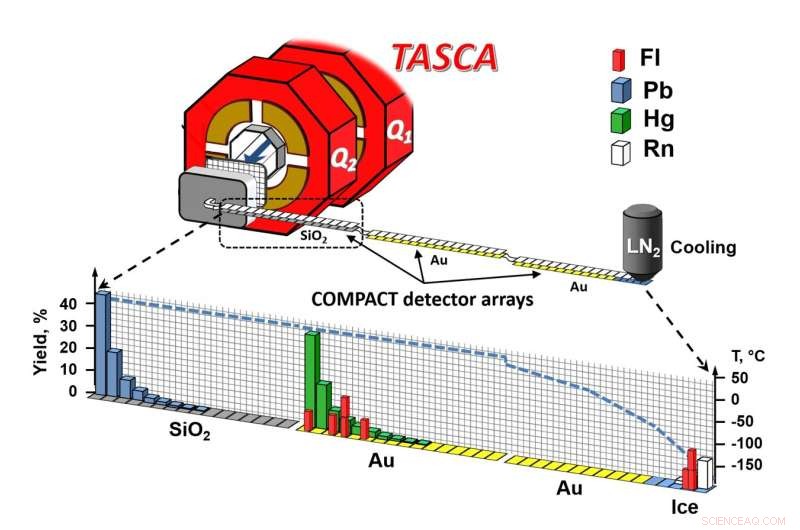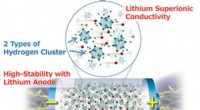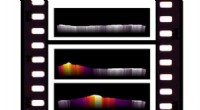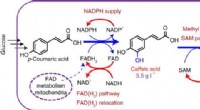
Wetenschap
Onderzoek toont aan dat flerovium het meest vluchtige metaal is in het periodiek systeem

Schematische weergave van de opstelling van het experiment. Krediet:A. Yakushev, GSI/FAIR
Een internationaal onderzoeksteam kreeg nieuwe inzichten in de chemische eigenschappen van het superzware element flerovium - element 114 - in de versnellerfaciliteiten van het GSI Helmholtzentrum für Schwerionenforschung in Darmstadt. Uit de metingen blijkt dat flerovium het meest vluchtige metaal is in het periodiek systeem. Flerovium is dus het zwaarste element in het periodiek systeem dat chemisch is bestudeerd.
Met de resultaten, gepubliceerd in het tijdschrift Frontiers in Chemistry , GSI draagt bij aan de studie van de chemie van superzware elementen en opent nieuwe perspectieven voor de internationale faciliteit FAIR (Facility for Antiproton and Ion Research), die momenteel in aanbouw is.
Onder leiding van groepen uit Darmstadt en Mainz werden de twee langstlevende fleroviumisotopen die momenteel bekend zijn, flerovium-288 en flerovium-289, geproduceerd met behulp van de versnellerfaciliteiten van GSI/FAIR en chemisch onderzocht in de TASCA-experimentele opstelling. In het periodiek systeem wordt flerovium onder het lood van het zware metaal geplaatst.
Vroege voorspellingen hadden echter gepostuleerd dat relativistische effecten van de hoge lading in de kern van het superzware element op zijn valentie-elektronen zouden leiden tot edelgasachtig gedrag, terwijl recentere eerder een zwak metaalachtig gedrag hadden gesuggereerd. Twee eerder uitgevoerde scheikunde-experimenten, waarvan één bij GSI in Darmstadt in 2009, leidden tot tegenstrijdige interpretaties.
Terwijl de drie atomen die in het eerste experiment werden waargenomen, werden gebruikt om edelgasachtig gedrag af te leiden, gaven de gegevens verkregen bij GSI een metaalachtig karakter aan op basis van twee atomen. De twee experimenten waren niet in staat om het karakter duidelijk vast te stellen. De nieuwe resultaten laten zien dat flerovium, zoals verwacht, inert is, maar in staat is om sterkere chemische bindingen te vormen dan edelgassen, als de omstandigheden daarvoor geschikt zijn. Flerovium is dan ook het meest vluchtige metaal in het periodiek systeem.
Flerovium is dus het zwaarste chemische element waarvan het karakter experimenteel is bestudeerd. Met de bepaling van de chemische eigenschappen bevestigt GSI/FAIR hun leidende positie in het onderzoek naar superzware elementen.
"Het verkennen van de grenzen van het periodiek systeem is sinds het begin een pijler van het onderzoeksprogramma van GSI geweest en zal dat in de toekomst ook op FAIR zijn. Het feit dat een paar atomen al kunnen worden gebruikt om de eerste fundamentele chemische eigenschappen te verkennen, geeft een indicatie van hoe grotere hoeveelheden van deze stoffen zich zouden gedragen, is fascinerend en mogelijk dankzij de krachtige versnellerfaciliteit en de expertise van de wereldwijde samenwerking", zegt professor Paolo Giubellino, Scientific Managing Director van GSI en FAIR. "Met FAIR brengen we het universum naar het laboratorium en verkennen we de grenzen van de materie, ook van de chemische elementen."
Zes weken experimenteren
De experimenten die bij GSI/FAIR werden uitgevoerd om de chemische aard van flerovium op te helderen, duurden in totaal zes weken. For this purpose, four trillion calcium-48 ions were accelerated to ten percent of the speed of light every second by the GSI linear accelerator UNILAC and fired at a target containing plutonium-244, resulting in the formation of a few flerovium atoms per day.
The formed flerovium atoms recoiled from the target into the gas-filled separator TASCA. In its magnetic field, the formed isotopes, flerovium-288 and flerovium-289, which have lifetimes on the order of a second, were separated from the intense calcium ion beam and from byproducts of the nuclear reaction. They penetrated a thin film, thus entering the chemistry apparatus, where they were stopped in a helium/argon gas mixture.
This gas mixture flushed the atoms into the COMPACT gas chromatography apparatus, where they first came into contact with silicon oxide surfaces. If the bond to silicon oxide was too weak, the atoms were transported further, over gold surfaces—first those kept at room temperature, and then over increasingly colder ones, down to about –160 °C.
The surfaces were deposited as a thin coating on special nuclear radiation detectors, which registered individual atoms by spatially resolved detection of the radioactive decay. Since the decay products undergo further radioactive decay after a short lifetime, each atom leaves a characteristic signature of several events from which the presence of a flerovium atom can unambiguously be inferred.
One atom per week for chemistry
"Thanks to the combination of the TASCA separator, the chemical separation and the detection of the radioactive decays, as well as the technical development of the gas chromatography apparatus since the first experiment, we have succeeded in increasing the efficiency and reducing the time required for the chemical separation to such an extent that we were able to observe one flerovium atom every week," explains Dr. Alexander Yakushev of GSI/FAIR, the spokesperson for the international experiment collaboration.
Six such decay chains were found in the data analysis. Since the setup is similar to that of the first GSI experiment, the newly obtained data could be combined with the two atoms observed at that time and analyzed together.
None of the decay chains appeared within the range of the silicon oxide-coated detector, indicating that flerovium does not form a substantial bond with silicon oxide. Instead, all were transported with the gas into the gold-coated portion of the apparatus within less than a tenth of a second.
The eight events formed two zones:a first in the region of the gold surface at room temperature, and a second in the later part of the chromatograph, at temperatures so low that a very thin layer of ice covered the gold, so that adsorption occurred on ice.
From experiments with lead, mercury and radon atoms, which served as representatives of heavy metals, weakly reactive metals as well as noble gases, it was known that lead forms a strong bond with silicon oxide, while mercury reaches the gold detector. Radon even flies over the first part of the gold detector at room temperature and is only partially retained at the lowest temperatures. Flerovium results could be compared with this behavior.
Apparently, two types of interaction of a flerovium species with the gold surface were observed. The deposition on gold at room temperature indicates the formation of a relatively strong chemical bond, which does not occur in noble gases. On the other hand, some of the atoms appear never to have had the opportunity to form such bonds and have been transported over long distances of the gold surface, down to the lowest temperatures.
This detector range represents a trap for all elemental species. This complicated behavior can be explained by the morphology of the gold surface:it consists of small gold clusters, at the boundaries of which very reactive sites occur, apparently allowing the flerovium to bond. The fact that some of the flerovium atoms were able to reach the cold region indicates that only the atoms that encountered such sites formed a bond, unlike mercury, which was retained on gold in any case.
Thus, the chemical reactivity of flerovium is weaker than that of the volatile metal mercury. The current data cannot completely rule out the possibility that the first deposition zone on gold at room temperature is due to the formation of flerovium molecules. It also follows from this hypothesis, though, that flerovium is chemically more reactive than a noble gas element.
The exotic plutonium target material for the production of the flerovium was provided in part by Lawrence Livermore National Laboratory (LLNL), U.S.. In the Department of Chemistry's TRIGA site at Johannes Gutenberg University Mainz (JGU), the material was electrolytically deposited onto thin titanium foils fabricated at GSI/FAIR.
"There is not much of this material available in the world, and we are fortunate to have been able to use it for these experiments that would not otherwise be possible," said Dr. Dawn Shaughnessy, head of the Nuclear and Chemical Sciences Division at LLNL. "This international collaboration brings together skills and expertise from around the world to solve difficult scientific problems and answer long-standing questions, such as the chemical properties of flerovium."
"Our accelerator experiment was complemented by a detailed study of the detector surface in collaboration with several GSI departments as well as the Department of Chemistry and the Institute of Physics at JGU. This has proven to be key to understanding the chemical character of flerovium. As a result, the data from the two earlier experiments are now understandable and compatible with our new conclusions," says Christoph Düllmann, professor of nuclear chemistry at JGU and head of the research groups at GSI and at the Helmholtz Institute Mainz (HIM), a collaboration between GSI and JGU.
How the relativistic effects affect its neighbors, the elements nihonium (element 113) and moscovium (element 115), which have also only been officially recognized in recent years, is the subject of subsequent experiments. Initial data have already been obtained as part of the FAIR Phase 0 program at GSI. Furthermore, the researchers expect that significantly more stable isotopes of flerovium exist, but these have not yet been found. However, the researchers now already know that they can expect to find a metallic element. + Verder verkennen
Nuclear physicist's voyage toward a mythical island
 Welke intermoleculaire krachten kunnen een neonatoom hebben?
Welke intermoleculaire krachten kunnen een neonatoom hebben?  Hoe Negatieve Celsius naar Fahrenheit te converteren
Hoe Negatieve Celsius naar Fahrenheit te converteren  Raamwerkdiversiteit van koolstofnitrides biedt een rijk platform voor katalyse met één atoom
Raamwerkdiversiteit van koolstofnitrides biedt een rijk platform voor katalyse met één atoom Bariumruthenaat:een hoog rendement, gemakkelijk te hanteren perovskietkatalysator voor de oxidatie van sulfiden
Bariumruthenaat:een hoog rendement, gemakkelijk te hanteren perovskietkatalysator voor de oxidatie van sulfiden The Steps for a Science Fair Project on the Rubber Egg
The Steps for a Science Fair Project on the Rubber Egg
Hoofdlijnen
- Hoe levert embryologie bewijs voor evolutie?
- Stadia van meiose met een beschrijving
- Studie onthult hoe de adelborst zijn paar uur lang in stand houdt
- Wetenschappers bestuderen overleving van zaailingen in landschap na natuurbrand
- Welke gebeurtenis volgt DNA-replicatie in een celcyclus?
- De microbiologische kunst van het maken van een betere worst
- Een aanpassing 150 miljoen jaar in de maak
- Convergente evolutie van mimetische vlinders verwart classificatie
- Onverwachte bevinding in de energiecentrale van cellen
- Ongebruikelijke suiker van cyanobacteriën werkt als natuurlijk herbicide

- Nieuw onderzoek toont aan dat alle solid-state batterijen met de hoogste energiedichtheid nu mogelijk zijn

- Wetenschappers laten onderzoekshydrogel meer als biologische weefsels groeien

- Chemische reacties visualiseren met infraroodthermografie

- Cofactor-engineering stimuleert de synthese van natuurlijke producten

 Componenten van Homeostasis
Componenten van Homeostasis  Kleine lifters vallen kankercellen aan:gouden nanosterren leveren als eerste medicijn rechtstreeks aan kankercelkern
Kleine lifters vallen kankercellen aan:gouden nanosterren leveren als eerste medicijn rechtstreeks aan kankercelkern Terwijl ransomware woedt, debat laait op bij reactie
Terwijl ransomware woedt, debat laait op bij reactie Onderzoekers demonstreren zeer efficiënte emissie van dispersieve golven in met gas gevulde holle-kern fotonische kristalvezels
Onderzoekers demonstreren zeer efficiënte emissie van dispersieve golven in met gas gevulde holle-kern fotonische kristalvezels Innovatieve dunnere elektrolyt kan de werking van vaste-oxidebrandstofcellen verbeteren
Innovatieve dunnere elektrolyt kan de werking van vaste-oxidebrandstofcellen verbeteren Ultrasnelle laserpulsen ontmoeten magnetische materialen in nieuw onderzoek
Ultrasnelle laserpulsen ontmoeten magnetische materialen in nieuw onderzoek Nieuwe maatstaf voor gelijkheid onthult een vollediger beeld van het welzijn van mannen
Nieuwe maatstaf voor gelijkheid onthult een vollediger beeld van het welzijn van mannen Astronaut voltooit ruimtewandeling zonder helmcamera lichten (update)
Astronaut voltooit ruimtewandeling zonder helmcamera lichten (update)
- Elektronica
- Biologie
- Zonsverduistering
- Wiskunde
- French | Italian | Spanish | Portuguese | Swedish | German | Dutch | Danish | Norway |

-
Wetenschap © https://nl.scienceaq.com

